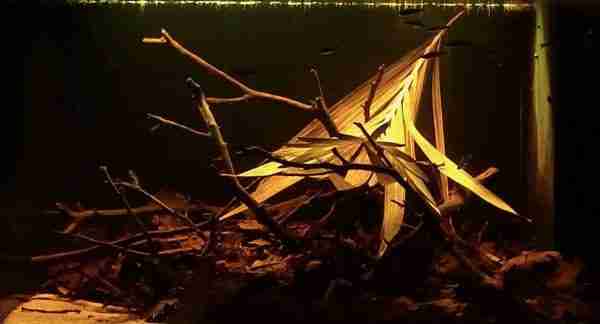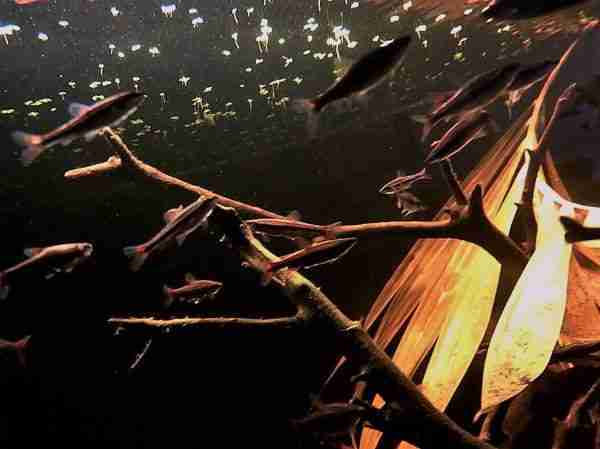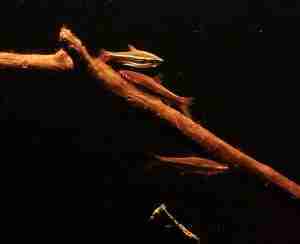A Suriname Biotope

Biotope 3: A small blackwater creek near Jodensavanne in Suriname
Dimensions: 70*50*35 (l*d*h)
Lightning: 1 x Aquatlantis Easy Led 6800 K (28 W) – time controlled.
Filter: Internal sump with 2 sizes mechanical filtration media and a biological filtration medium. Peat substrate is added to the filter. Pump of 100 l/h circulates the water.
 Substrate: White sand mostly covered by leaves and alder cones.
Substrate: White sand mostly covered by leaves and alder cones.
Water change: Automatic with 2 episodes of adding fresh water each day by a dripping system.
Water temperature: Controlled by a aquarium heater of 200 W. Water temperature in this systems could be relatively high (26-28°C) due to high air temperature, but is somewhat tempered by the creek forest.
Plants: None
Fish: Nannostomus beckfordi and Apistogramma steindachneri

Biotope description: This aquarium simulates a blackwater creek near Jodensavanne in Suriname. Black waters owe their striking red-brown color to the absence of inorganic turbidity and the absorption of short wavelenghts of light by humic acids. They have typically low pH and almost no hardness.
These creeks are associated with the white sandy podzol soils of meters of bleached quartz below a layer of humus covered by a thin hard layer. Percolation of rainwater carry away the organic matter through the podzol. In this way Dissolved Organic Carbon passes its way to the creeks. Most of these creeks have clear water and temperatures are quite high.
Although biomass is quite low in these systems, one can find several spectacular fish species like Copella arnoldi, Hyphessobrycon species, Gymnotus carapo, Polycentrus dwarf cichlid by locals).
 Aquatic vegetation consists of Cabomba aquatica and Nymphaea sp. that thrive in these circumstances.
Aquatic vegetation consists of Cabomba aquatica and Nymphaea sp. that thrive in these circumstances.
In this aquarium I chose to leave the plants and focus on the leaf litter and sandy parts of the creek. The thick layer of leaves is highly appreciated by the Apistogramma. Although there are beautiful pristine areas left in Suriname, human impact is obvious. Renovation of old roads lead to (temporarily) disturbance of the creeks.
Gold and bauxite mining are causing serious damage to freshwater systems in Suriname, with increasing turbidity and huge loads of dangerous substances that affect the fish and other species (i.e. the bioaccumulation of methyl mercury through the foodchain).
by Jeroen Vanhooren
photos courtesy Jeroen Vanhooren
 Biotope One A Study of Flora and Fauna
Biotope One A Study of Flora and Fauna 


